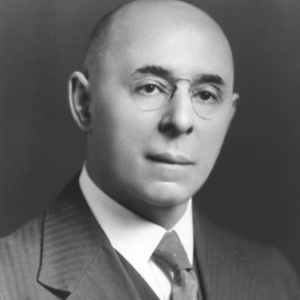Lazare Saminsky, born Lazar Semyonovich Saminsky (Russian: Лазарь (Элиэзер) Семенович Саминский; Valegozulovo, near Odessa, 27 October 1882 O.S. / 8 November N.S. – Port Chester, New York, 30 June 1959), was a performer, conductor and composer, especially of Jewish music.
Born to a merchant family, Saminsky received a broad education in the arts, sciences and languages. He studied music at the Odessa conservatoire from 1903–1905, and then went to Moscow where he studied mathematics and philosophy as well as music. Expelled for his participation in the student protests of 1905, he went to St.Petersburg where he studied with Nikolai Rimsky-Korsakov, Anatoly Lyadov and Nikolai Tcherepnin.
While still a student he became a founder member, with Mikhail Gnesin and others, of the ‘Society for Jewish Folk Music’. He wrote music for the Society and helped organise its earliest publication. He continued an active member, even though from 1911 to 1918 he lived in Tiflis, where he also interested himself in Georgian and Armenian music, and from 1917 to 1918 he was head of the Conservatoire. During this period he also wrote an opera Tsar Yulian (Emperor Julian) (which he later destroyed), and researched Jewish music of the Caucasian region. He was particularly interested in styles of cantillation (nigun).
In 1919 Saminsky left the Soviet Union and travelled to France and England, where he gave recitals of Russian and Jewish music, and led a ballet season at the Duke of York’s Theatre in London, where he married the English poet Lillian Morgan. In December 1920 he left to settle in the United States, where he was active as a composer, conductor and organiser of musical events. In 1922 he became a board member of the International Composers Guild. From 1924 he was music director of the Temple Emanu-El Synagogue in New York City. For the synagogue he composed music for the Sabbath and Holiday services, also commissioning work from other Jewish composers including Joseph Achron and Isidor Freed.
Saminsky’s major compositions include the ‘First and Second Hebrew Song Cycles’ opp. 12 and 13 (written in 1914, published New York, 1922, text in Yiddish), songs, choral works and piano pieces.
Saminsky wrote numerous books on Jewish music, contemporary music and conducting.


10 thoughts on “Kaminos”
Was Nicholas related to Alexander Saslavsky who married Celeste Izolee Todd?
Anyone have a contact email for Yair Klinger or link to score for Ha-Bayta?
wish to have homeland concert video played on the big screen throughout North America.
can organize here in Santa Barbara California.
contacts for this needed and any ideas or suggestions welcomed.
Nat farber is my great grandpa 😊
Are there any movies or photos of max kletter? His wife’s sister was my stepmother, so I’m interested in seeing them and sharing them with his wife’s daughter.
The article says Sheb recorded his last song just 4 days before he died, but does not tell us the name of it. I be curious what it was. I’d like to hear it.
Would anyone happen to know where I can find a copy of the sheet music for a Gil Aldema Choral (SATB) arrangement for Naomi Shemer’s “Sheleg Al Iri”. (Snow on my Village)?
Joseph Smith
Kol Ram Community Choir, NYC
שלום שמעון!
לא שכחתי אותך. עזבתי את ישראל בפברואר 1998 כדי להביא את בני האוטיסט לקבל את העזרה המקצועית שלא הייתה קיימת אז בישראל. זה סיפור מאוד עצוב וטרגי, אבל אני הייתי היחיד עם ביצים שהביא אותו והייתי הורה יחיד בשבילו במשך חמישה חודשים. הוא היה אז בן 9. כעת הוא בן 36 ומתפקד באופן עצמאי. נתתי לו הזדמנות לעתיד נורמלי. בטח, אבות כולם חרא, אומרים הפמינציות, אבל כולם צריכים לעבוד כמטרות במטווחי רובה!
משה קונג
(Maurice King)
Thank you for this wonderful remembrance of Herman Zalis. My late father, Henry Wahrman, was one of his students. Note the correct spelling of his name for future reference. Thank you again for sharing this.
Tirza Wahrman (Mitlak)
amazing zchuso yagein aleinu, he wrote the famous niggun Lefichuch that is sung in almost every Israeli Yeshiva